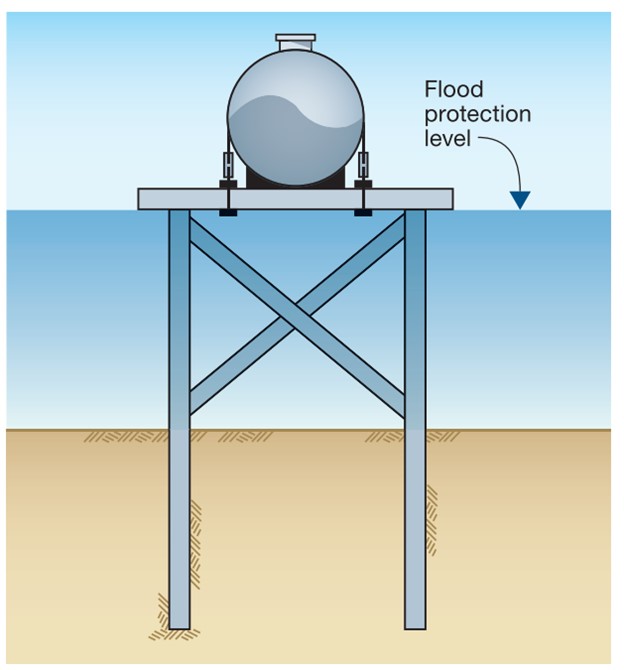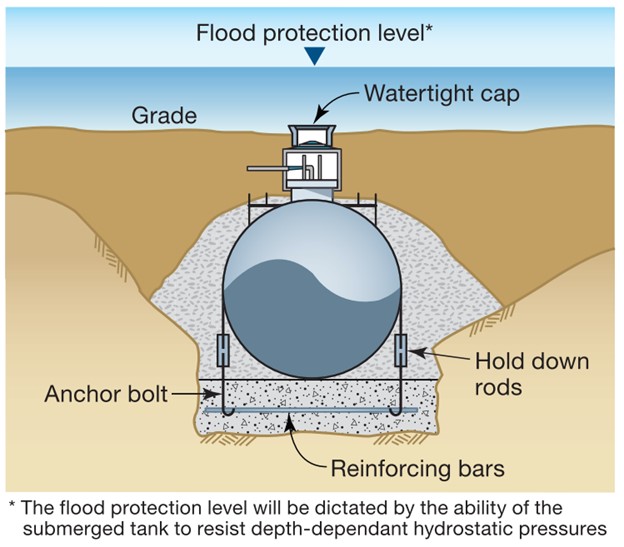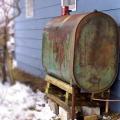Scope
In locations prone to earthquakes, floods, hurricanes, and tornadoes, anchor and secure fuel tanks and distribution lines to reduce the risk of fuel leakage, fire, explosions, damage to tanks and surrounding property, and harm to people.
- Secure tanks to prevent them from becoming detached via flotation, seismic shaking, wind forces, or collision with other unsecured objects during extreme weather events.
- Prevent forceful damage to the fuel tank supply line.
See the Compliance Tab for links to related codes and standards and voluntary federal energy-efficiency program requirements.
Description
Homes that use fuel oil or propane for space heating, hot water, cooking, or fireplaces will often have large storage tanks for these fuels located on site. Whether the tank is located above ground or below ground, or indoors or outdoors, it is imperative that the tank be anchored to the ground or a strong structural component to reduce safety risks in case of flooding, earthquakes, or tornadoes (FEMA P-348 2017), to Improve the possibility of continued safe use during or directly following a disaster event, and to reduce repair scope following adverse weather.
An unanchored liquid propane, natural gas, or fuel oil tank can become a significant physical and environmental hazard during a natural disaster. If left unanchored, a fuel tank located outside of the home can be knocked off of its base by flood waters, hurricane-force winds, or seismic activity, breaking fuel lines and possibly crashing into the home or other buildings (Figure 1) (Home Innovation Research Labs 2012). Similarly, if an unanchored fuel tank located in the basement is moved by flood waters or seismic activity, the supply line can detach. This can contaminate the home with oil or gas and present a fire hazard. These hazards can be reduced by securing the fuel tank, which is often a simple process that can be accomplished using a few straps and anchors (Home Innovation Research Labs 2012).

(Source: FEMA P-259 2012)
Floods can present several additional hazards for tanks, especially tanks located on or below ground. The tank or its components can be hit by flood-borne debris; metallic tank or fuel line components can be oxidized by corrosive elements in the floodwaters; sensitive control devices like pressure regulators, solenoids, and meters can be destroyed by flood water; relief valves can allow floodwaters to get into the tank and oil or gas to flow out of the tank; and buried tanks can be exposed by rapid erosion, especially in coastal floods that include wave action (FEMA P-348 2017).
Flood waters can also lift submerged tanks out of the ground due to buoyant forces. If the flood forces exceed the weight of an above-ground tank and the fuel within, then the tank is at risk of displacement. For underground tanks, if the flood forces exceed the combined weight of the tank, the fuel within, and any soils above the tank, the tank can be displaced. Buoyant forces are proportional to the volume of floodwater displaced. As more of the tank is submerged, the buoyant forces increase. Once a tank is fully submerged, buoyant forces are maximized because greater flood depths do not displace greater amounts of floodwater. The net buoyant forces are less on full tanks than on empty tanks, but full tanks can release their contents when floodwater reaches their fill or vent piping. Refer to Section 5W.13 of FEMA P-259, Engineering Principles and Practices for Retrofitting Flood-Prone Residential Structures, for additional details on how to determine the net buoyant force on a tank and the volume of concrete required to offset buoyancy (FEMA P-348 2017).
Another possible impact of floodwaters is that submerged tanks can also be crushed by flood forces. For each foot of flood depth, freshwater flooding exerts compressive forces of 62.4 pounds per square foot of tank surface while saltwater exerts compressive forces of 64.0 pounds per square foot. Because compressive forces increase as flood depths increase, tanks exposed to deeper floodwater are much more prone to crushing failure. A fuel tank placed on a basement floor can be exposed to much larger compressive forces than a tank placed in a shallow crawlspace. Similarly, underground tanks can be exposed to greater compressive loads than those placed at grade (FEMA P-348 2017).
Whether elevated, at grade, or buried, fuel tanks should be anchored to resist the buoyancy effects of flood waters and movement from floods or earthquakes. In coastal areas, tanks should be installed on the landward side of the building; in riverine areas, they should be installed on the downstream side of buildings. Piping and components should be protected from flood loads. Piping can be installed in vertical chases and attached to sturdy parts of the building. In coastal areas, piping should be buried deeper than expected flood and wave scouring (FEMA P-348 2017).
FEMA has defined Special Flood Hazard Areas (SFHAs) where the National Flood Insurance Program (NFIP)’s floodplain management regulations must be enforced. The various SFHAs, including Zones V, A, and Coastal Zone A, are defined at the bottom of this page.
Tanks Elevated
The most effective flood protection technique for fuel storage tanks is elevation of the tank above the Design Flood Elevation (DFE). The DFE is the elevation of the highest flood a protective measure is designed to withstand, usually based on the 100-year flood. In A Zones, tanks can be elevated on platforms, frames, or on structural fill. Methods to elevate tanks are shown in Figures 2 and 3 (FEMA P-348 2017). When the tank is elevated on compacted structural fill, a concrete slab is often placed on top of the fill material for anchorage. Figure 3 shows a tank elevated on fill. In V Zones and Coastal A Zones, however, structural fill is not allowed for new construction or Substantially Improved homes, as defined by the National Flood Insurance Program (FEMA P-348 2017).
When elevated, the tanks themselves are not likely to be exposed to flood forces during a design flood; however, they still require anchoring and support to resist wind loads and, in seismic areas, earthquake loads. (See definitions at the end of this tab.) The fuel tank should be secured to the platform with straps or anchors to prevent movement caused by high winds or seismic events. In coastal zones, the anchors should be made of non-corrosive material to reduce potential damage from salt spray (FEMA P-348 2017).
In V Zones and Coastal A Zones, the platform should be supported by posts or columns that are adequately designed for all loads including flood, wind, and earthquake. Bracing may be required to address loads from moving floodwater and structural redundancy may be appropriate to protect against debris impact. The lowest horizontal member of the supporting frame should be above the wave crest. The foundation should be deep enough to resist loads after being undermined by the predicted levels of erosion and scour. A braced pile or post platform may be necessary in riverine locations where moving water and debris pose a risk (FEMA P-348 2017).


Tanks at or Below Grade
To meet the national Flood Insurance Requirements, when elevating the tank above the DFE is not feasible, new tanks and tanks for Substantially Improved homes must be designed to resist flood loads and prevent the release of their contents, as described in ASCE 24 (see Compliance tab). Also, ASCE 24 specifies that both above-ground and underground tanks be designed and installed to resist 1.5 times the flood loads acting on an empty tank. Those loads are not just the buoyant forces that tend to dislodge tanks but also the compressive forces that could crush tanks exposed to floodwater (FEMA P-348 2017).
When fuel tanks cannot be elevated or relocated, dry floodproofing may be an option if the residence is not newly constructed or Substantially Improved. Dry floodproofing is any measure which is designed to physically block flood waters from reaching the tank. For new construction and Substantially Improved residences, dry floodproofing is not allowed by the National Flood Insurance Program (NFIP) for residential occupancy (FEMA P-348 2017).
Adding weight (dead load) to the foundations supporting the tanks helps resist buoyant forces. Concrete is commonly used to help anchor tanks. Because concrete placed below a flooded tank displaces floodwater and, like the tank, is exposed to buoyant forces, only the submerged weight of the concrete provides resistance to buoyant forces on the tank. Hence, when determining the net buoyant force, the full weight of the concrete can be included in the calculation provided that the volume of the concrete is included as part of the total volume of floodwater displaced. Figure 4 shows a tank installation where concrete is used to resist buoyant forces. Helical earth anchors are occasionally used to resist buoyant forces (see Figure 5). The anchors should be designed to take into account the soil type and any reduction in capacity due to saturated soil conditions. All anchors and connecting hardware should be corrosion resistant (FEMA P-348 2017).


Definitions
The FEMA document, Coastal Hazards & Flood Mapping: A Visual Guide, defines Special Flood Hazard Areas (SFHAs), including Zones V and A and Coastal Zone A. Special Flood Hazard Areas are areas where the National Flood Insurance Program (NFIP)’s floodplain management regulations must be enforced. Flood insurance is required in these areas because of the high risk of flooding (FEMA 2021).
CHHA - Coastal High Hazard Area. A Coastal High Hazard Area (CHHA) is identified as Zone V or Zone VE on FEMA flood maps.
Zone VE and V – Called “V zones”, these are areas where waves and fast-moving water can cause extensive damage during the base flood event. In V zones, wave heights are larger than 3 feet. The label Zone VE refers to areas for which a detailed study has been done and base flood elevations (BFEs) have been calculated. The label “Zone V” means that a detailed study has not been done for the area, so BFE has not been calculated but wave hazards are still expected. Structures in areas mapped as Zone V and Zone VE are subject to stricter building requirements because of the higher risk of damage from strong waves.
Zone A – Coastal Zone A areas include areas landward of a V Zone, or landward of an open coast without mapped V Zones. In a Coastal Zone A, the principal source of flooding will be astronomical tides, storm surges, seiches or tsunamis, not riverine flooding.
Zone AE - Zone AE is used to label parts of the SFHA on flood maps in coastal and non-coastal areas. In coastal areas, AE zones indicate areas that have at least a 1-percent-annual-chance of being flooded and wave heights are less than 3 feet. For Zone AE, detailed analyses have been performed and BFEs have been calculated.
Zone AO - Zone AO shows areas at risk of flooding during the base flood, where water 1 to 3 feet deep flows over sloping ground. On coastal maps, Zone AO usually marks areas at risk of flooding from wave overtopping, where waves are expected to wash over the crest of a dune or bluff and flow into the area beyond. In AO zones, flood depth is expressed as a height above natural ground. Homes and other buildings in these areas are still vulnerable to flooding from waves, even if they are on higher ground or behind a wall or other structure (FEMA 2021).
Success
Ensure that tank installation complies with National Flood Insurance Program requirements for the home’s location.
Climate
Consult National Flood Insurance Program maps to determine the flood risk of your location. FEMA’s Flood Map Service Center website provides tools home owners and builders can use to determine the flood risk of their specific location.
Training
Compliance
Retrofit
The measures described for new homes on the Description tab can also be used for existing homes.
More
More Info.
Access to some references may require purchase from the publisher. While we continually update our database, links may have changed since posting. Please contact our webmaster if you find broken links.
The following authors and organizations contributed to the content in this Guide.
The following authors and organizations contributed to the content in this Guide.














